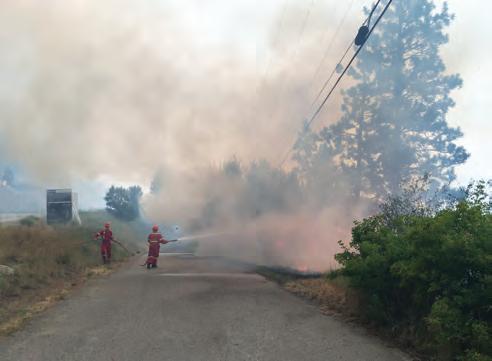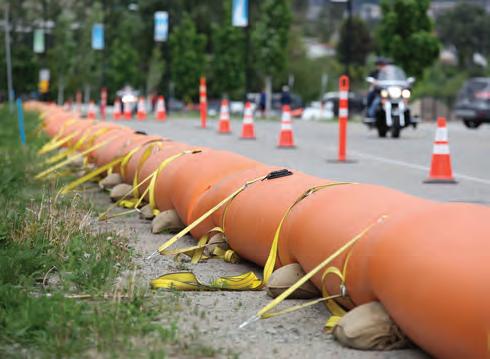
3 minute read
REGIONAL EMERGENCY PROGRAM
Travis Whiting, COORDINATOR
The Regional Emergency Program is coordinated by the City of Kelowna Fire Department on behalf of the Regional District, the cities of Kelowna and West Kelowna, districts of Lake Country and Peachland and the Westbank First Nation. The plan makes provisions for the community in the event of any emergency such as flooding, forest fires, or other catastrophes that impact our residents.
Advertisement
Officials from each local government, work with many other agencies, including the RCMP, fire departments, BC Ambulance, Interior Health, School District 23, public works, transportation, communications and Emergency Support Services (ESS) volunteers. These group regularly meet and practice the plan, which also includes activating the Emergency Operations Centre (EOC) in the main Kelowna fire hall.
The Emergency program provides information during incidents to residents and media through Twitter (twitter.com/CO_Emerg) and Facebook (www. facebook.com/CORDEmergency). Residents may also subscribe to emergency notifications and find real time updates at the CORD Emergency website: www.cordemergency .ca
The plan also provides guidelines for recovery operations after any emergency or disaster ends.
Evacuation Stages
Evacuation Alert - The alert highlights the nature of the danger and that people should be prepared to evacuate the area with short notice. The Evacuation Alert may allow for the population at risk to begin an orderly preparation to voluntarily leave the affected area.
Evacuation Order - The population at risk is ordered to immediately evacuate a specified area defined by the Evacuation Order. While the evacuation order is in effect, the area will have controlled and restricted access.
Rescind - The population at risk is allowed to return to the area previously evacuated, having been advised that the danger has passed. There is the possibility that the danger may reoccur and the Evacuation Alert may need to be upgraded or Evacuation Order might need to be reissued or reinstated.
Emergency Operation Centre Activation Levels
Level One – small event, one site
Level Two – medium event, two or more sites with limited evacuations
Level Three – major event involving multiple sites and extensive evacuations
2018 | HIGHLIGHTS
« The Regional Emergency Program coordinated and hosted ongoing training courses and workshop sessions for over 100 local government staff involved in Emergency Management.
« In late February and mid-April, the Information Office issued news releases and social media posts encouraging Central Okanagan residents in low-lying and flood prone areas to make annual preparations for the possibility of flooding. Within a few months, for the second year in a row the Okanagan saw water levels rising substantially in area creeks and lakes which caused isolated flooding.
« Emergency Preparedness Week May 6-12 the Information Office issued a new release and social media posts raising residents awareness of the importance of planning for emergencies and involving all family members in preparing emergency grab-and-go kits.
« The Emergency Operation Centre was activated on April 18 to support first responders throughout the Central Okanagan for localized flooding as local governments declared States of Emergencies. This response resulted in several Evacuation Orders for isolated areas affected by overland flooding, landslides and potential slides. As well, they allowed governments to take proactive measures to protect flood prone areas and local infrastructure from potential flood damage. It was June 19 before all threats had passed and the last of the States of Emergency expired and the EOC closed. Through this period the Information Office issued 47 news releases along with hundreds of social media posts.
« July 27 through July 29, the EOC was activated at a Level Three supporting the City of Kelowna Fire Department as it and the BC Wildfire Service responded to the intense Yates Road wildfire. Almost 1,000 properties in the Wilden area above the fire were on alert during the three day response.
« The Regional ESS (Emergency Support Services) program was very active during 2018. Volunteers were active assisting with several evacuations during the flooding and summer fire season. They staffed an Emergency Evacuation Reception Centre for those displaced by the Mt. Eneas wildfire, south of Peachland.
- In addition, ESS volunteers were deployed to assist and staff reception centres in Prince George and Burns Lake for residents who were evacuated by wildfires across northern BC.
2019 | INITIATIVES
« A review of 2018, including updates to Operating Guidelines and incorporation of lessons learned will continue into early 2019 to ensure the EOC is ready again for potential events during the year.
« Ongoing training of current and future EOC staff will commence for early spring in all areas of Emergency Response to prepare for the upcoming Freshet and Wildfire Season.
« Replacement of core technical equipment and updating of technology will provide enhancements to the EOC
« On July 18 the Emergency Operation Centre was activated due to the threats posed by the Mt. Eneas and Goode Creek wildfires and to support Peachland Fire Rescue and the BC Wildfire Service in fighting these blazes. These fires, along with one called the Law Creek fire west of West Kelowna were renamed the Okanagan Complex, resulting in evacuations and alerts for thousands of residents. The Emergency Operation Centre closed on July 29 after conditions improved and all affected residents were allowed to return to their homes.
« Continue to work with staff from local governments across the region on training and preparedness in advance of the Spring Freshet (flooding) season and wildfire season.
« Prepare and commence updating of Central Okanagan Regional Hazard, Risk and Vulnerability Analysis, Emergency Response Procedures and Emergency Program Bylaw.











